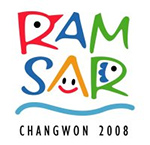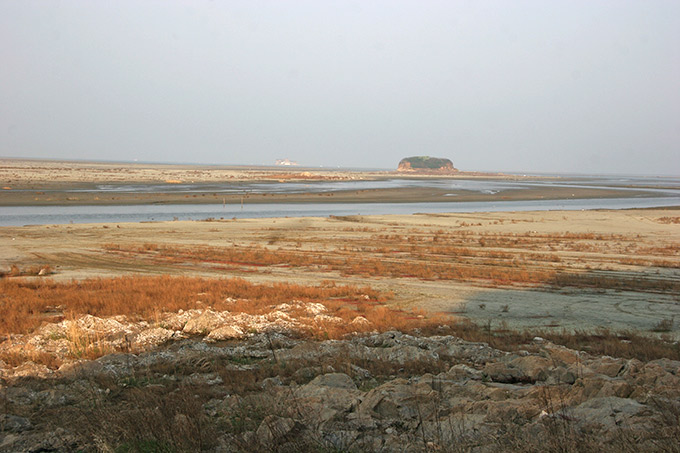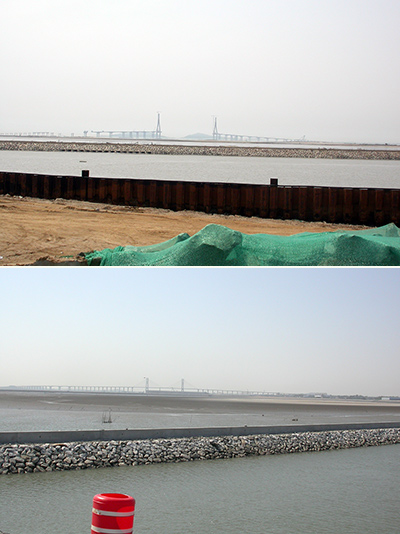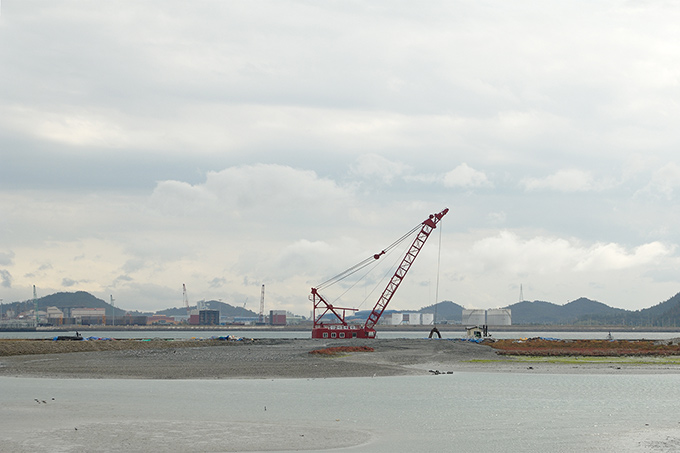
The Tenth Ramsar Convention conference (CoP 10) is being held here in the Republic of Korea, in Changwon City, between October 28th and November 4th, 2008. It is preceded and followed by numerous meetings – on conservation of cranes, of the DMZ, CEPA, World NGO Congress, East Asian Tidal-flat Conservation, Migratory Birds (and climate change), and the Flyway Partnership, to list but a few. It is clear that there are many interrelated and important issues to consider, and that this is a period in which much can be achieved for conservation. In the understanding that a large part of Birds Korea’s role is to increase public and political support for bird and wetland conservation (through the provision of honest information and apolitical insight), we here provide some background information on what we believe to be four main areas of concern. These are: The Republic of Korea’s (ROK’s) very poor Ramsar record to date; the continuation of coastal reclamation; the proposed Korean Grand Canal Project; and the untimely and misleading focus on restoration over conservation. If these can be dealt with honestly and openly, then progress towards wetland conservation will be rapid.
1) The Republic of Korea’s Ramsar record
A nation’s Ramsar record can perhaps most easily be measured in terms of policy improvements and in the number and quality of wetlands that it designates as Ramsar sites.
While there have been multiple improvements in domestic laws and policies since accession in 1997, perverse incentives remain that permit and encourage the degradation of many of the nation’s remaining wetlands, including e.g. Special Laws for the development of Saemangeum and for the development of the Coastal Zone (covered in more detail in the 2006-2008 SSMP report and elsewhere on our websites).
The ROK has at present (October 25th, 2008) eight Ramsar sites formally listed (see: http://www.ramsar.org/sitelist.doc), the same as or more than 105 other Contracting Parties. The ROK is therefore ranked about joint 50th in the number of Ramsar sites it has designated. A further three sites will also be listed shortly (according to a mid-October press release), meaning that the ROK could soon move into the world’s “Top 40”: on the surface, a great and worthwhile achievement. This focus on the number of Ramsar sites tells only a very small part of the story, however. Wetlands are typically part of much wider and interconnected catchment areas. Many nations recognize this and have therefore either designated huge areas as Ramsar sites, or have designated a large number of small sites. The ROK has done neither. The eight listed sites in the ROK total only 8149 ha. The three additional sites when registered will still only bring the total area of Ramsar site in the ROK to approximately 8900 ha: less than one-quarter the size of the just one wetland reclamation (destruction) project: Saemangeum. Eight thousand nine hundred hectares is a very small percentage of national territory or of the nation’s wetland. It is clearly inadequate to conserve the nation’s wetlands and wetland biodiversity.

A close look at the Ramsar list shows that only 25 out of the 158 nations listed as Ramsar Contracting parties have a smaller area of Ramsar site than the ROK. The ROK therefore fails to even make the global “Top 120”. Further, of these 25, 23 are much smaller in national area than the ROK (examples include tiny Monaco and Liechtenstein). There appear in fact to be just two nations that have a greater national area than the ROK and a smaller area of Ramsar site: Myanmar/Burma and Libyan Arab Jamahiriya (Libya). While poverty might prevent a nation from pursuing long-term sustainable development (i.e. conservation) over short-term use, the ROK (on 2007 data) already has the 13th or 14th biggest GDP in the world. For comparison, Libya ranks approximately 62nd, and Burma 103rd globally in terms of GDP. As a rich nation with many important wetlands, the ROK needs more, and much larger, Ramsar sites.
Moreover, the few Ramsar sites that have been designated to date, while important, do not include many of the most globally important wetlands: parts of the DMZ (and adjacent areas), the Han-Imjin Estuary, the tidal-flats of Song Do and the Geum Estuary, Saemangeum, the Nakdong Estuary etc. Rather, many of our present Ramsar sites are tiny freshwater sites. Only two of the eight that are listed (and none of the three to be listed) appear to contain inter-tidal wetlands - yet inter-tidal wetlands are a beautiful and essential part of the ROK’s unique national and natural heritage; they support the majority of the nation’s globally threatened waterbird species; and they already provide multiple services and benefits to people, including commercial fisheries.
Further, several of the wetlands that have been designated as Ramsar sites (including Upo and Suncheon) are suffering extensive development and disturbance (on-site and in surrounding areas). Most existing Ramsar sites in the ROK appear to lack management plans that will allow the long-term maintenance of either their biodiversity or their ecological character.
This is all far from the picture painted by most of the overly-enthusiastic domestic publicity for the Ramsar CoP.
The solution to this is relatively easy (and is already largely-described by Ramsar literature): use money (e.g. spent on advertising and big meetings) to invest in training of wetland (rather than wetland centre) managers; and develop Ramsar site management plans that are open and transparent, and that involve local stakeholders and independent experts.
2) Tidal-flat reclamation

While there have been repeated public and formal statements made (including to Ramsar Standing Committee meetings) that the national government will permit no more large-scale tidal-flat reclamation, many of the nation’s internationally important tidal-flats are still either being reclaimed or are threatened with reclamation. Saemangeum is the most well-known case. However, Song Do tidal-flats in Incheon (supporting at least 13 waterbird species in Ramsar-defined internationally important concentrations) are being reclaimed, with the last remaining areas awaiting imminent reclamation; Asan Bay (formerly one of the nation’s most important areas for shorebirds) is a patchwork of reclamation sites; and even the tidal-flats at Aphae island in Shinan Gun will soon be part-reclaimed for port construction – a project permitted as recently as July this year (2008). It is not only the more well-known internationally important wetlands that are threatened: even part of the wonderful Mokpo Namhang Urban wetland is now being in-filled, with the latest phase of construction work starting within a week of the opening of the Ramsar CoP.
To achieve wise use of Korean wetlands, there is a clear need to revoke the Public Waters Reclamation Act (which has encouraged decades of reclamation), and to cancel all reclamation projects that threaten especially internationally important wetlands.
3) The Korean Grand Canal Project
The Korean Grand Canal mega-development would canalise thousands of kilometers of rivers, a quarter of the nation’s Important Bird Areas, and several estuaries. That it has ever been proposed, and has even been proposed as another “environmentally-friendly” development (!), provides some of the best evidence to date that the nation’s decision-makers have been very poorly-advised on wetland conservation. We therefore strongly applaud the decision to suspend this project (in mid-2008), and we hope, respectfully, that the Ramsar CoP 10 will provide a wonderful opportunity for the nation’s leaders to announce its permanent cancellation.
4) Restoration
The Ramsar Convention makes clear that conservation is to be preferred to restoration – being cheaper, more effective, and more achievable. While failing to conserve remaining wetlands, the ROK already has a multitude of restoration plans targeting both wetlands and wetland species.
The Mokpo Namhang Urban wetland provides an excellent example of what is wrong with the planning process. Already part-reclaimed, Birds Korea (along with many others) believes that with a small investment this 50 ha wetland could provide a wonderful urban resource: for biodiversity conservation, for environmental education, for recreation. We have worked to this end with local decision-makers (in Mokpo City council); we have worked with national and international experts; and we have worked to provide information freely to the government body responsible for this area’s future use. The response? While the national Ministry of Land, Transportation and Maritime Affairs actively promotes wetland restoration and wise use (and no net loss of wetland) through its National Wetland Management Plan (2007), the local office of the very same ministry in Mokpo has this week ordered in the bulldozers, to infill part of the wetland. Their rationale as told to us in September: This development is part of a 10 year old plan. It cannot be changed.

Species restoration plans are also popular, and in several cases similarly perverse. Examples include the so-called restoration into the ROK of the Crested Ibis Nipponia nippon. According to media reports (e.g. http://news.xinhuanet.com/english/2008-10/17/content_10209835.htm) a pair of this globally endangered species has recently been purchased from China and has been shipped to Korea. There is, however, no published historical information (that Birds Korea can trace) to show that the species ever bred here. Rather, the Crested Ibis is considered by previous authors (including Austin [1948], Gore and Won [1971] and Park [2002]) to be only a local, non-breeding winter visitor, that has not been recorded in the ROK for decades. While publicity banners and posters show Crested Ibis flying free over Upo Ramsar site (one intended site for “restoration”), there is no published record of Crested Ibis at Upo wetland, ever. Further, the heavily-disturbed 854 ha Upo has been extensively degraded since Ramsar designation a decade ago, and is often crowded with visitors. BirdLife International (http://www.birdlife.info/wbdbwebstaging/SpcHarnessDetails.asp?sclass=3801&m=0) identifies agro-chemicals, conversion of rice-fields and lack of food (especially in winter) as potential threats to this species. Upo wetland is surrounded by pine woodland and large areas of leek fields, heavily treated with agricultural chemicals. Contra the expert guidance on restoration provided by the Ramsar Convention and by the IUCN, no efforts have yet been made to remove factors that would limit the species there. It is extremely hard to understand how Upo Ramsar site could be considered fit for the “restoration” of this globally endangered species.
The Republic of Korea is a success story and rightly a leader in so many ways. Hosting the Ramsar CoP 10 now offers all of us in the ROK a great opportunity: to discuss, to learn, and to help change policies away from wetland destruction towards genuinely wise and sustainable use. The Ramsar CoP10 provides us all with a chance that needs to be taken in full: to help enable the ROK to fulfill national sustainable development targets and to meet the necessary demands of the United Nations Millennium Development Goals.
With this as our focus, Birds Korea, as always with your continuing support, looks forward to the CoP, and to the weeks and months ahead! Let this be the time for change!



